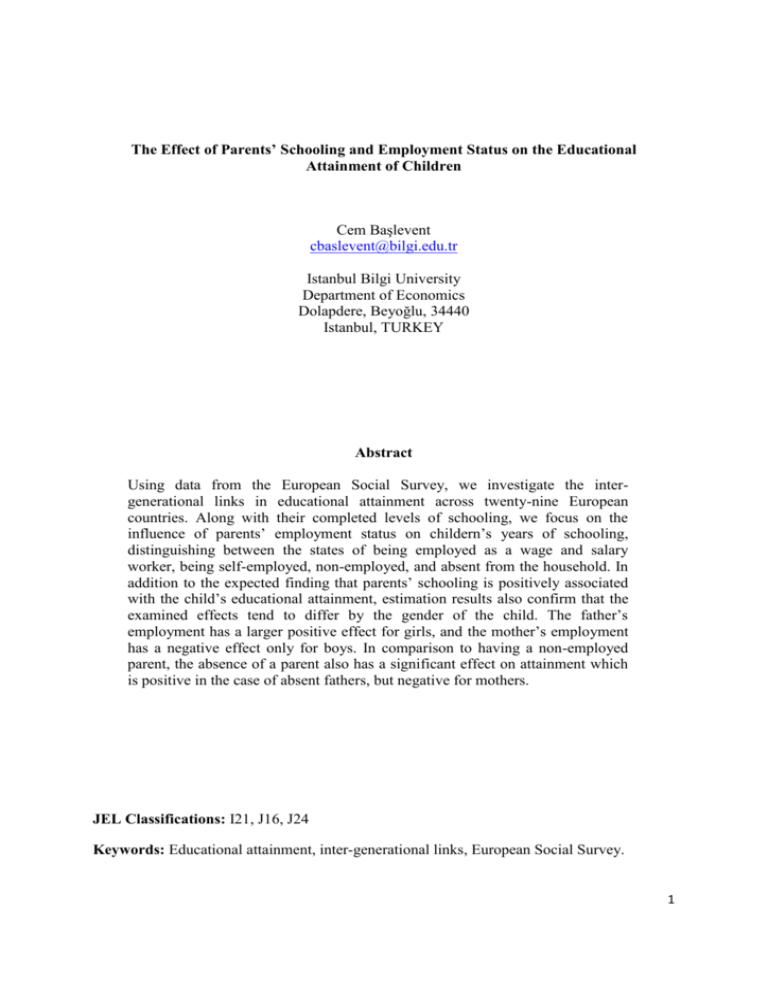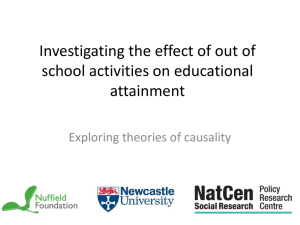The Effect of Parents` Schooling and Employment Status on the
advertisement

The Effect of Parents’ Schooling and Employment Status on the Educational Attainment of Children Cem Başlevent cbaslevent@bilgi.edu.tr Istanbul Bilgi University Department of Economics Dolapdere, Beyoğlu, 34440 Istanbul, TURKEY Abstract Using data from the European Social Survey, we investigate the intergenerational links in educational attainment across twenty-nine European countries. Along with their completed levels of schooling, we focus on the influence of parents’ employment status on childern’s years of schooling, distinguishing between the states of being employed as a wage and salary worker, being self-employed, non-employed, and absent from the household. In addition to the expected finding that parents’ schooling is positively associated with the child’s educational attainment, estimation results also confirm that the examined effects tend to differ by the gender of the child. The father’s employment has a larger positive effect for girls, and the mother’s employment has a negative effect only for boys. In comparison to having a non-employed parent, the absence of a parent also has a significant effect on attainment which is positive in the case of absent fathers, but negative for mothers. JEL Classifications: I21, J16, J24 Keywords: Educational attainment, inter-generational links, European Social Survey. 1 1. Introduction One of the most commonly studied aspects of socio-economic inter-generational mobility within families is to what extent the educational outcomes of individuals are associated with the schooling levels of their parents (e.g. Hertz et al., 2007; Heineck and Riphahn, 2008). Though the examination of the relationship in question may at first seem to be a straightforward task, complex models have been developed for both conceptual and methodological reasons. Feinstein, Duckworth, and Sabates (2004) argue, for example, that parental education is a major influence both directly and through other channels such as income and parenting skills and that part of the effect of parents’ education is in moderating the effects of other elements. The authors also point to the fact that the inter-generational transmission of educational attainment is not necessarily a desirable outcome as it implies the transmission of economic status between parents and children which, in turn, leads to persistence of social class differences and a barrier to equality of opportunity. Further evidence along this line has been reported in Ianelli (2003) and Ianelli and Smyth (2008) where it has been demonstrated that the relative advantage of having more educated parents emerges as stronger in the Eastern European countries (characterized by a disorderly transition towards a capitalist economy) and weaker in the Nordic European countries known for their more universalistic Welfare State policies. The pattern generally agreed upon in the empirical literature is that parents’ educational attainment has a positive impact on their children’s educational outcomes, and that the human capital of the mothers is of more relevance than the fathers’ (Haveman and Wolfe, 1995).1 This is despite the contrary evidence presented in some recent studies in which the impact of unobserved inherited abilities and the assortative mating of the parents are controlled for. Using data for the U.S., Behrman and Rosenzweig (2002) and Plug (2004) have found, on samples of twins and adopted children, respectively, that the mother’s schooling has little, if any, impact on the schooling of her children. Furthermore, Ganzach (2000) reports evidence for the interactions between parents' education, cognitive ability of the child, and educational expectations in determining educational attainment. This latter finding implies that obtaining reliable estimates can be tricky even when abilities are controlled for. In this paper, we use data drawn from the European Social Survey (ESS) to examine the determinants of educational attainment across Europe. We are particularly interested in exploring the extent of inter-generational links, i. e. the effect of the parents’ schooling levels and employment statuses on the respondents’ educational attainment.2 We estimate the econometric model in the male and female subsamples to observe whether the slope coefficients differ by the child’s gender. Since our empirical work does not involve adjustments for unobserved characteristics and possible endogeneities, the reported estimates should be used primarily for the purpose of making cross-country comparisons and interpreted as representations of the associations between the variables rather than causal effects. 1 See Jerrim and Micklewright (2009) for a summary of the findings of related studies. It would be best to think of the current study as a follow-up to the Başlevent and Kirmanoğlu (2010) paper where the focus is on accounting for cross-country differences in intergenerational links. An early version of that paper was presented at the Ecomod 2010 conference held in İstanbul, Turkey. 2 2 Depending on the theoretical assumptions being made, there are several ways the intergenerational transmission of educational outcomes can be explored empirically in a regression context. The econometric work could feature a restrictive model which omits the mother’s schooling level altogether, but it could also utilize a comprehensive one which assumes both parents to have different effects for male and female children. Using data on multiple countries from the International Stratification and Mobility File (ISMF), Johnston, Ganzeboom and Treiman (2005) carry out an extensive study to operationalize and test the various models suggested in the literature. They conclude that a model that allows for gender differences at both generations should be used to ensure that all observable patterns are accounted for. Determining the direction of the relationship between parents’ employment and the cognitive and educational outcomes of their children has also been the purpose of several empirical studies. Probably due to their different ways of handling the potential endogeneities involved, the evidence obtained in these studies has been mixed (Duncan et al., 1998; Harvey, 1999). However, the general belief is that mothers’ employment has a negative impact on educational attainment even though the magnitude of the net effect is ambiguous due to the presence of an indirect positive effect through household income.3 The information provided in the ESS pertains to the employment status of the respondent’s parents when the respondent was at the age of 14. This information provides only a crude measure of the ‘employment effect’ since it ignores the intensity (i.e. number of hours) of work and the incidence of employment at different developmental stages of a child. Working with more detailed employment data to examine children’s educational attainment, Ermisch and Francesconi (2000) distinguish between full-time and part-time employment and also employment when the child was aged 0-5, 6-10, and 11-15. In comparison with part-time employment and the employment of the father, they find a greater significant negative effect of the mother’s fulltime employment when the child was aged 0-5, but they also report that the effects persist when the parents’ employment patterns over the entire childhood period are examined. Besides their employment statuses, parents’ occupations have also been linked to their children’s educational attainment. Using data for the Netherlands, Ganzeboom (2009) finds that parents’ occupations matter for both the educational attainment and the occupational choice of their children. The effect of occupation is found to be present even when the mother was not gainfully employed (which is the case for the majority of mothers) when the respondent was growing up. The author also finds evidence in favor of the ‘same-sex role model hypothesis’ which implies that fathers matter more for male children, and mothers matter more for female children. Despite some of its shortcomings as far as the employment information is concerned, the ESS data distinguishes between wage and salary work and selfemployment which might prove useful in certain contexts. In an effort to pack the employment and occupation effects together without introducing too many variables into the analysis, we utilized a more aggregate grouping in our preliminary work and classified parents with respect to their employment status at their workplaces, i.e. based on whether they were engaged in wage and salary (employee) or own-account (self-employment) work when the respondent was 14. 3 Using a sample of adopted children to obtain genetically unbiased estimates and correcting for biases arising from unobserved parenting qualities, Plug and Vijverberg (2005) find that family income has a significant effect on educational attainment. 3 2. The ESS Data and the construction of variables in the model Initiated in 2001 with the cooperation of the European Commission, European Science Foundation, and 26 national Research Councils, the European Social Survey (ESS) aims to monitor attitudes and behaviors across countries and over time. For the current study, we use Edition 4.0 of the data from the fourth round of the ESS fielded in 2008. This version of the data was published on February 2, 2011 and comprises the following 30 countries: Belgium, Bulgaria, Croatia, Cyprus, the Czech Republic, Denmark, Estonia, Finland, France, Germany, Greece, Hungary, Ireland, Israel, Latvia, Lithuania, the Netherlands, Norway, Poland, Portugal, Romania, Russian Federation, Slovakia, Slovenia, Spain, Sweden, Switzerland, Turkey, Ukraine, and the United Kingdom. Lithuania is excluded from our analysis due to the absence of design weights for this country. The question of how the background variables in cross-national surveys can be compared has previously been addressed by several researchers. The educational attainment information presents its own specific set of problems as one needs to compare the respondents’ education acquired under different national systems (Hoffmeyer-Zlotnik and Warner, 2008). In measuring the children’s, i.e. the respondents’, educational attainment, there are several measures we can we can choose from. One of these is a newly-developed categorical variable based on the work of Schneider (2009), consisting of seven levels, but this variable is available only for the following 20 countries: Belgium, Croatia, Czech Republic, Denmark, Estonia, France, Germany, Hungary, Latvia, Netherlands, Norway, Poland, Portugal, Romania, Russian Federation, Slovakia, Slovenia, Spain, Switzerland and Ukraina. This variable will be used as an alternative measure of schooling in a sensitivity analysis of the main results. The seven categories in question are: 1 ES-ISCED I , less than lower secondary 2 ES-ISCED II, lower secondary 3 ES-ISCED IIIb, upper secondary, vocational or no access V1 4 ES-ISCED IIIa, upper secondary, general and/or access to V1 5 ES-ISCED IV, advanced vocational, sub-degree 6 ES-ISCED V1, lower tertiary education, BA level 7 ES-ISCED V2, higher tertiary education, >= MA level Another measure is a five-level variable that does not distinguish between vocational and academic education. This variable has replaced a 7-category variable appearing in earlier versions of the data set. The 5-way categorization, produced as part of an effort to achieve harmonization across countries, allows for a less ambitious, but more realistic multi-country examination of inter-generational transmission of educational attainment. The five categories in question are: 1 Less than lower secondary education 2 Lower secondary education completed 3 Upper secondary education completed 4 Post-secondary non-tertiary education 5 Tertiary education completed 4 Finally, the ‘years of education’ variable available for the respondents measures the total amount of time spent at school. This variable is less popular in the literature due to the fact that completed levels are better indicators of educational success and the amount of human capital acquired at school. However, in the current study, we focus our attention on this variable since our primary concern is on measuring the inequality of educational opportunity as measured by the extent of inter-generational links which is better measured by the amount of time one can afford to spend at school. In measuring parents’ educational attainment, however, we use the 5-way categorization (rather than year equivalents) to allow for a detailed examination of the hypothesized relationships. (See Appendix 1 for the country-level means of schooling variables). A complicating factor in the measurement of inter-generational links using a multi-country data set is the need to account for the fact that there is likely to be a large amount of variation in the extent to which the relationship is observed across the countries that make up the sample. This heterogeneity brings about the use of multi-level estimation techniques, i.e the introduction of country-level variables, to ensure that more reliable estimates are obtained. Taking this approach, Başlevent and Kirmanoğlu (2010) have demonstrated – using data from an earlier ESS round – that the variation in coefficient estimates can, to a large extent, be explained by the countrywide inequality in the distribution of the schooling variable itself. To be specific, the links are stronger in countries where there’s more inequality in the distribution of educational attainment, which is consistent with the idea that the links in question have to do with the inequalityies of opportunity existing in the society. Given this information, we have transformed the years of schooling variable to have a standard mean and variance in each country. Though it is not as rigorous as employing multilevel estimation techniques – which would require the determination of appropriate country-level variables –, this method is meant to alleviate the problem of having a heterogeneous group of countries with regard to the nature of the relationships under examination. 3. Empirical work The empirical work is carried out on the sample of non-students aged 25 and over (which is the cut-off point used in many studies on this topic), assuming that these people will not be going back to school. In the econometric model to be estimated, we have controls for the gender of the respondent as well as his/her age (along with ‘age-squared’) to account for the general increasing trend in educational attainment. The household income information provided in the data is not used, however, as it refers to the present income level of the respondent rather than the income level enjoyed when s/he was growing up. We have made use of the ‘design weights’ available in the data set to obtain nationally-representative country samples, but not the ‘population weights’ since we did not want our results to be dominated by the patterns in large-population countries. To allow for fixed differences across countries, we have included country dummies in the regressions. Along with the use of a standardized measure of schooling, we expect these dummies to contribute to the harmonization of data gathered from a large number of countries. One of the main findings of the regression analysis is that the educational attainment of the father has a greater impact on the years of schooling of the child than the mother’s. One reason for this pattern might be that the father’s attainment is more closely related with household income which we are not able to control for. Judging by the magnitudes of the 5 coefficient estimates, the father’s completion of tertiary education appears to have the largest incremental effect on the dependent variable. The impact of the father’s education is similar for male and female children, but it tends to be larger for male children. In contrast, the impact of the mother’s education tends to be larger for female children. Taken together, these findings provide evidence in favor of what is known as the same-sex role model hypothesis. The employment of the father, whether as a wage and salary worker or as self-employed, has a positive impact on the educational attainment of the child, regardless of the child’s gender. Once again, the main reason for this pattern must be that the father’s employment is closely related with household income which we are not able to control for. The effect on female children is larger than that on male children, especially when the father is self-employed. This might be because male children are more likely than females to work with their fathers and take over the family business at some point, in which case schooling is not a necessary investment for them. Another reason – which applies to both types of employment – could be that the sons’ educational attainment is less sensitive to the household income level. However, with coefficient estimates of around 0.2, all of these effects appear to have less ‘economic’ significance than statistical significance. The coefficients on the mother’s employment variables are even smaller in magnitude. Furthermore, the direction of the effect of the mother’s employment varies by the type of work and the gender of the child. While the wage and salary work of the mother has a positive effect on the schooling of daughters, there is no such effect in the case of the sons. Assuming that this type of work requires more schooling and a stronger attachment to the labor force, this finding may reflect the parents’ attitude towards their daughter’s eventual labor market involvement. Non-employment of the mother, on the other hand, may reflect more conservative views regarding women’s role in social life, and this may have an influence on the amount of investment made in a female child’s education. We also find that having a self-employed mother leads to less years of schooling in the case of daughters (as well as in the full sample). This could be because the self-employment of the mother implies more responsibilities at home for the daughter (assuming that self-employemtn implies longer working hours in comparison to wage and salary work) or because the daughter joins the mother in the workplace at an early age. It turns out that an absent father has a positive effect on the child’s attainment, but the absence of the mother has no significant effect. Recalling that these are in comparison to having a non-employed parent, we interpret this result as evidence of a more non-stable or dysfunctional family setting in case of a non-employed father. Of course, it might also be argued that single-parent families need to be excluded from the analysis altogether. However, the only information we can use to identify such families is to work with our ‘father/mother absent at the age of 14’ indicators. Estimation results - not reported here - reveal that the patterns summarized above remain mostly unchanged following the exclusion of respondents whose father or mother was absent when the child was 14 years old. 4. Concluding remarks The aim of this study was to uncover the nature of inter-generational links in educational outcomes in Europe using data for 29 countries covered by the fourth round of the European Social Survey. Regression results revealed several interesting results regarding the 6 differences between the effects on male and female children. An intriguing aspect of intergenerational links we have not dealt with rigorously is the degree of cross-country heterogeneity in the extent of these links. At this point, we find it difficult to speculate on which macro factors lead to effects of different magnitudes in different countries. This variation may have to do with cross-country differences in the employment shares, schooling requirements, income levels, or average hours of work associated with wage and salary work and self-employment. Examination of such factors at the country level using additional data sources should shed more light on the nature of the inter-generational links. Such an approach would also imply the use of multilevel estimation methods that allow for a more complex distributional structure. Another point that calls for further investigation is whether a parent’s absence from the household at younger ages than 14 could have a greater or smaller effect on the educational attainment of the child. Therefore, a data set that contains more detailed information regarding the parents, as well as household income figures (for the past) that one would ideally like to be able to control for, is likely to provide further insights into the relationships examined here. References Başlevent, C., and H. Kirmanoğlu (2010) “Accounting for the Heterogeneity in Inter-generational Links in Educational Attainment Across Europe”, European Research Studies, 13 (3), pp. 65-84. Behrman, J. and M. Rosenzweig (2002) “Does increasing women’s schooling raise the schooling of the next generation?”, American Economic Review, 92 (1), pp. 323–34. Duncan, G.J., W.J. Yeung, J. Brooks-Gunn, and J. Smith (1998) “How much does childhood poverty affect the life chances of children?”, American Sociological Review, 63 (3), 406-423. Ermisch, J. and M. Francesconi (2000) “The Effect of Parents' Employment on Children's Educational Attainment”, IZA Discussion Paper, No. 215. Feinstein L., K. Duckworth and R. Sabates (2004) “A Model of the Inter-generational Effects of Parental Education”, Centre for Research on the Wider Benefits of Learning, Research Report, No. 10. Ganzach, Y. (2000) “Parents’ education, cognitive ability, educational expectations and educational attainment: Interactive effects”, British Journal of Educational Psychology, 70 (3), pp. 419-41. Ganzeboom, H. B. G. (2009) “Mothers matter!”, Paper presented at the Spring meeting of Research Committee 28 on Social Stratification and Social Mobility of the International Sociological Association, Beijing, PRC, May 16, 2009. Green A., J. Preston and R. Sabates (2003) “Education, Equity and Social cohesion: a Distributional Model”, Centre for Research on the Wider Benefits of Learning, Research Report, No.7. Harvey, E. (1999), “Short-term and long-term effects of early parental employment on children of the National Longitudinal Survey of Youth”, Developmental Psychology, 35 (2), pp. 445–59. Haveman, R. and B. Wolfe (1995) “The Determinants of children attainments: A review of methods and findings”, Journal of Economic Literature, 33 (4), pp. 1829-78. 7 Hertz, T., T. Jayasundera, P. Piraino, S. Selcuk, N. Smith, and A. Verashchagina (2007) “The Inheritance of Educational Inequality: International Comparisons and Fifty-Year Trends.”, The B.E. Journal of Economic Analysis & Policy, 7(2), Article 10. Heineck, G. and R. T. Riphahn (2008) “Inter-generational transmission of educational attainment in Germany - the last five decades”, Jahrbücher für Nationalökonomie und Statistik (Journal of Economics and Statistics), 229 (1), pp. 36-60. Hoffmeyer-Zlotnik, J. H. P. and U. Warner (2008) “How to survey education for cross-national comparisons: The Hoffmeyer-Zlotnik/Warner-Matrix of education”, Proceedings of the 3mc2008 Conference, Berlin, Germany, June 25-28, 2008. Iannelli, C. (2003) “Parental education and young people’s educational and labour market outcomes: a comparison across Europe”. In: I. Kogan and W. Müller, eds. School-to-work transition in Europe: analyses of the EULFS 2000 Ad hoc module. Mannheim: MZES, pp. 27-53. Iannelli, C. and E. Smyth (2008) “Mapping gender and social background differences in education and youth transitions across Europe”, Journal of Youth Studies, 11 (2), pp. 213 – 232. Jerrim, J. and J. Micklewright (2009) “Children's education and parents' socio-economic status: Distinguishing the impact of mothers and fathers”, Paper presented at the Conference on Intergenerational Transmission, Madison, Wisconsin, September 2009. Johnston, A. D., H. B. G. Ganzeboom and D. J. Treiman (2005) “Mother’s and Father’s Influences on Educational Status Attainment”, Paper presented at the Conference “Welfare States and Inequalities” of Research Committee 28 on Social Stratification and Social Mobility of the International Sociological Association, Oslo, Norway, May 6-8, 2005. Plug, E. (2004) “Estimating the Effect of Mother's Schooling on Children's Schooling Using a Sample of Adoptees”, American Economic Review, 94 (1), pp. 358-68. Plug, E. and W. Vijverberg (2005) “Does Family Income Matter for Schooling Outcomes? Using Adoptees as a Natural Experiment”, The Economic Journal, 115 (506), p. 879-906. Schneider, S. L. (2009). Confusing credentials: The Cross-nationally comparable measurement of educational attainment. DPhil thesis, University of Oxford, Nuffield College, Oxford. Schneider, S. L. (2008) “Nominal comparability is not enough: (In-)equivalence of construct validity of cross-national measures of educational attainment in the European Social Survey”, Research in Social Stratification and Mobility, 28 (3), pp. 343-357. Schröder, H. and H. B. G. Ganzeboom (2009) “Scaling Education in the European Social Survey”, Paper presented at the European Survey Research Association Conference, Warsaw, Poland, July 2, 2009. UNESCO (2006 [1997]). International Standard Classification of Education: ISCED 1997 (reedition). Montreal: UNESCO Institute for Statistics. URL: http://www.uis.unesco.org/ TEMPLATE/pdf/isced/ISCED_A.pdf . 8 Table 1: Regression results All sample Coef. p-value Males Coef. p-value Females Coef. p-value 0.271 (0.000) 0.313 (0.000) 0.237 (0.000) 0.439 (0.000) 0.440 (0.000) 0.439 (0.000) 0.510 (0.000) 0.490 (0.000) 0.535 (0.000) 0.794 (0.000) 0.875 (0.000) 0.717 (0.000) 0.184 (0.000) 0.158 (0.000) 0.202 (0.000) 0.368 (0.000) 0.354 (0.000) 0.380 (0.000) 0.502 (0.000) 0.443 (0.000) 0.533 (0.000) 0.537 (0.000) 0.479 (0.000) 0.588 (0.000) 0.199 (0.000) 0.185 (0.000) 0.218 (0.000) Father self-employed 0.208 (0.000) 0.142 (0.000) 0.270 (0.000) Father absent 0.122 (0.000) 0.090 (0.043) 0.154 (0.000) Mother wage and salary worker 0.023 (0.039) 0.016 (0.343) 0.032 (0.028) Mother self-employed -0.058 (0.001) -0.038 (0.157) -0.068 (0.004) Mother absent -0.051 (0.129) -0.054 (0.281) -0.062 (0.165) Age 0.029 (0.000) 0.028 (0.000) 0.028 (0.000) Age 2 / 100 -0.040 (0.000) -0.035 (0.000) -0.042 (0.000) Female -0.048 (0.000) Constant -0.913 (0.000) -0.921 (0.000) -0.902 (0.000) Father completed lower secondary educ. Father completed upper secondary educ. Father completed postsecondary educ. Father completed tertiary educ. Mother completed lower secondary educ. Mother completed upper secondary educ. Mother completed postsecondary educ. Mother completed tertiary educ. Father wage and salary worker R-squared 0.249 0.215 0.292 No. of observations 42,403 19,276 23,127 Notes: The dependent variable is the child’s years of schooling. The coefficients on the country dummies have been omitted from the output. The reference category for parents’ educational attainment is “less than lower secondary”. The reference category for parents’ employment status is “non-employed”. 9 Appendix 1: The country-level means of educational attainment variables Years of schooling Belgium Bulgaria Switzerland Cyprus Czech Rep. Germany Denmark Estonia Spain Finland France U.K. Greece Croatia Hungary Ireland Israel Latvia Netherlands Norway Poland Portugal Romania Russia Sweden Slovenia Slovakia Turkey Ukraine Educational attainment (1-to-5) All children Males Females Fathers Mothers 12.8 11.3 11.5 11.8 12.8 14.0 12.9 12.9 10.8 13.0 12.9 13.8 11.3 11.8 12.1 14.0 13.3 12.5 13.5 13.7 12.1 7.4 12.0 12.7 12.9 11.5 13.4 5.7 12.6 13.1 11.4 11.6 12.2 12.9 14.4 12.7 13.0 11.0 12.9 13.0 13.7 11.4 11.9 12.5 13.6 13.0 12.4 14.0 13.6 12.1 7.9 11.9 12.6 12.8 11.9 13.8 6.5 13.0 12.5 11.3 11.4 11.3 12.7 13.4 13.1 12.9 10.6 13.0 12.8 13.8 11.3 11.6 11.9 14.4 13.5 12.6 13.1 13.7 12.0 7.0 12.0 12.7 13.1 11.2 13.1 4.8 12.4 2.3 2.3 2.8 1.6 3.0 3.3 2.9 2.6 1.5 2.0 2.0 2.1 1.5 2.5 2.0 1.9 2.7 2.4 2.2 3.0 2.4 1.2 2.4 2.7 2.0 2.5 2.8 1.2 2.9 2.0 2.2 2.3 1.5 2.8 2.7 2.5 2.5 1.3 1.9 1.7 1.9 1.3 2.1 1.9 2.0 2.6 2.5 1.8 2.6 2.3 1.1 2.2 2.8 1.9 2.3 2.6 1.0 2.9 10






